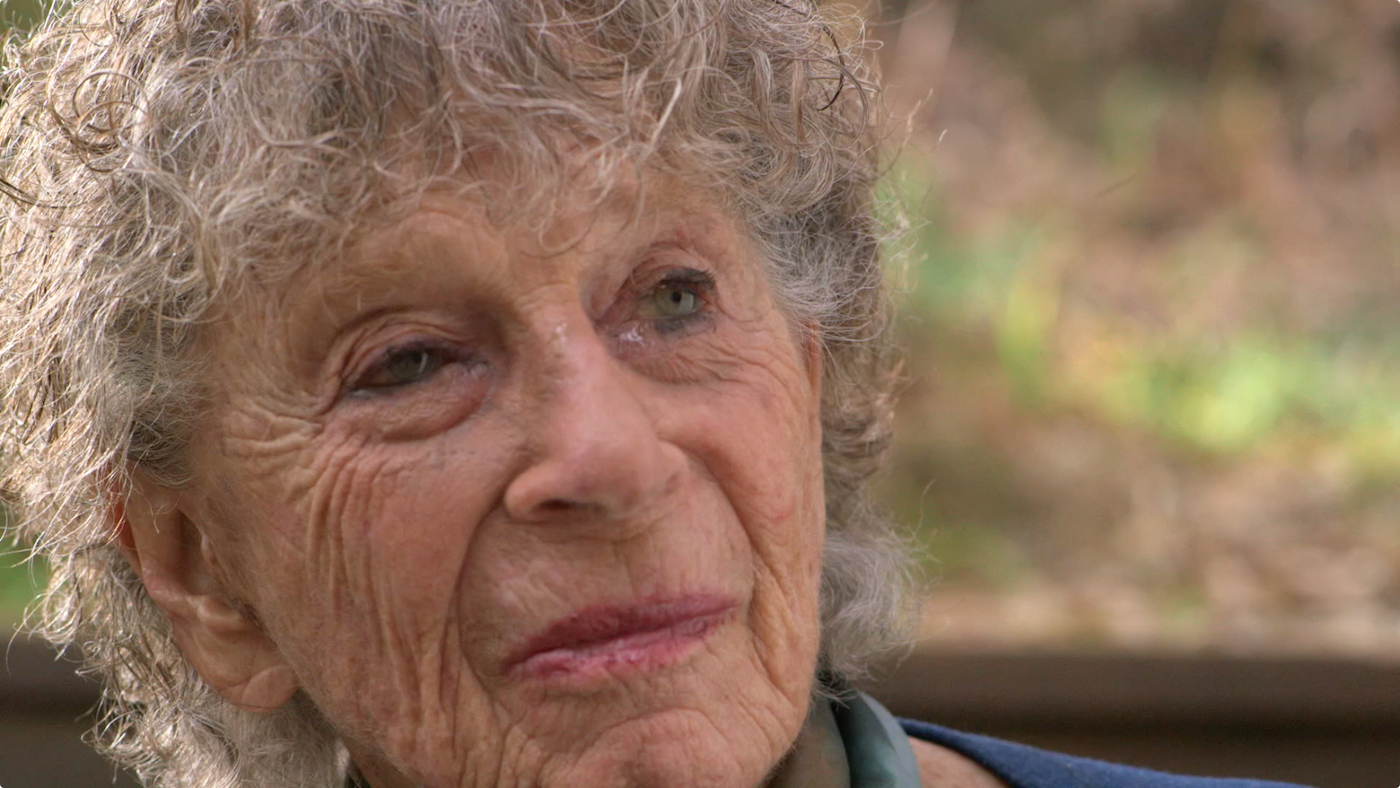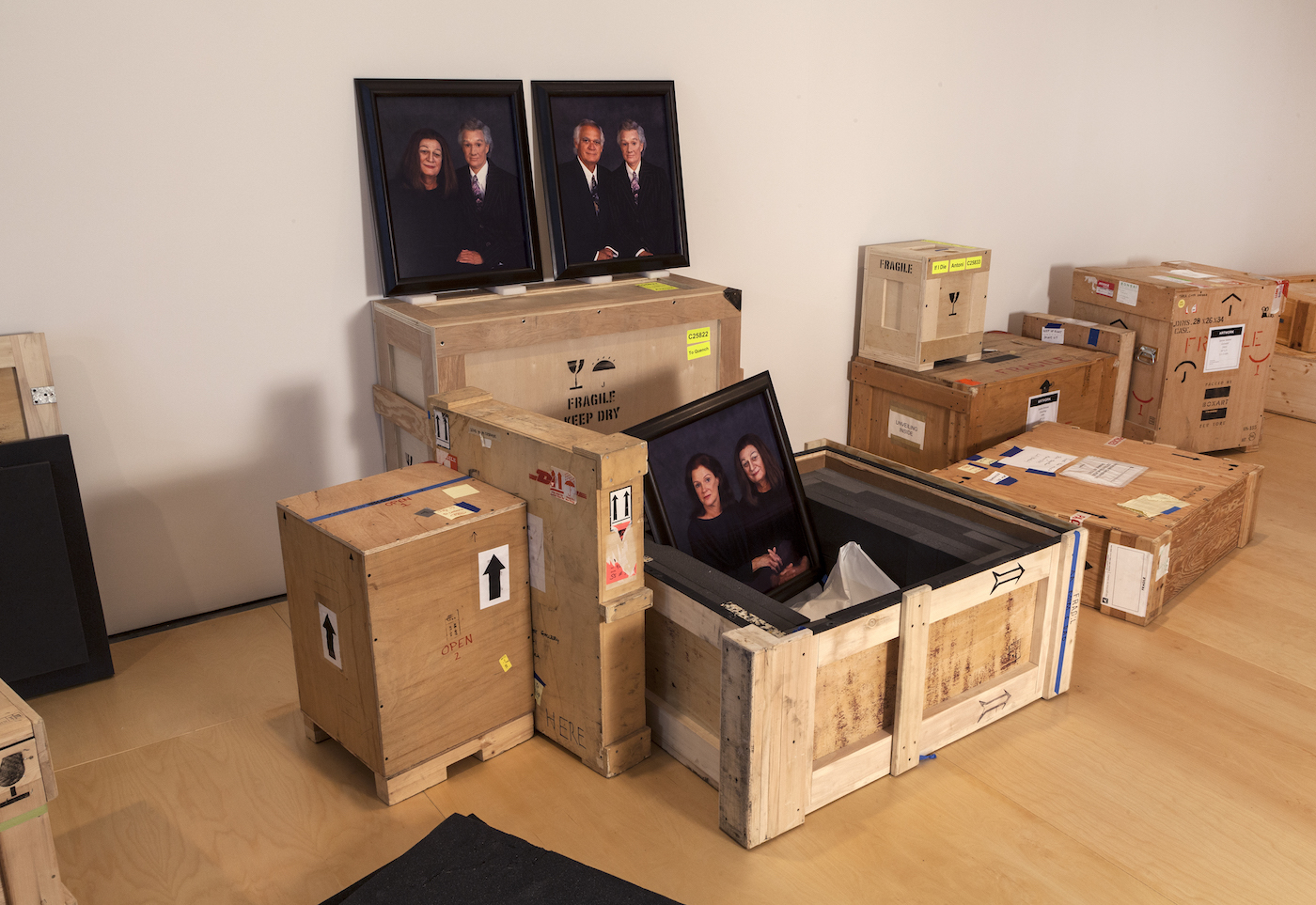
Stephen Petronio rendition of “The Courtesan and the Crone” by Anna Halprin (2016), exhibition detail from ‘Ally,’ produced in collaboration with the Fabric Workshop and Museum (photo by Carlos Avendaño; all images courtesy of the artists and the Fabric Workshop and Museum, Philadelphia)
PHILADELPHIA — Ally, an exhibition at the Fabric Workshop and Museum in Philadelphia, is a collaboration between artist Janine Antoni, choreographer Stephen Petronio, and movement artist and activist Anna Halprin. The result of years of cross-country rehearsals, the exhibition uses ephemera, performance, and soundscapes to perform a real-time study of the materiality of objects and the effects of the aging body.
The first performance I saw was a version of Halprin’s 1999 work “The Courtesan and the Crone,” reworked for the museum’s mostly concrete, tunnel-like seventh floor gallery. Halprin created the work at age 79 to address her own aging, changing body, and tenets of traditional (white and Eurocentric) female beauty. For Ally, Petronio takes on this role of the coy, elegant courtesan, expanding the embodiment of the character across gender lines. A tattered, red curtain lied on the far end of the space as Petronio slinked through, his face initially covered by an ornate mask. With a series of simple gestures indicating a conventionally feminine physicality — subtle shoulder rolls, the grabbing of a breast, a foot slipping into a pair of high heels — Petronio conjured a mystique that was both beautiful and grotesque, a female form in peril, trying to reclaim any sense of youthful exuberance while time moved against her.
It was not until Petronio gingerly peeled off his satin gloves, however, that it was evident this body was not what we thought it was. Exposing hairy knuckles and tattooed fingers, the shedding of this persona marked a potent reveal. There was something haunting in this image: a highly masculine-appearing performer engulfed in a persona that was not only flirtatious and decidedly feminine, but an examination of the standards women are held to in order to appear youthful and attractive. The male performer was the femme object; as he shed layers of his costume — dress, headpiece and, finally, mask — the materials of the performance set appeared to break down. The red curtain lowered and a sand bag descended, showing the pulley mechanism that often holds curtains aloft. At the end of the performance, Petronio hung his coat on the floating sandbag and sauntered off, effectively leaving the realization of this artifice behind him.

Janine Antoni, Anna Halprin, Stephen Petronio, “Rope Dance” (2015) (photo by and © Hugo Glendinning)
On the museum’s ground floor, “Rope Dance” offered a participatory experience. Centered on a thin rope, designed expressly for this exhibition by employees of the Fabric Workshop and Museum, the performance required the full engagement of its participants. After removing our shoes and being given a pair of headphones, we were met by a video projection of Halprin, filmed in 2014 at her California home (where she still resides at age 95). The camera remained centered on her face as it reacted subtly and steadily, as if she were recounting the day’s happenings to herself or coming upon a fresh memory. At first, Halprin appeared alone; her occasional slight smile or small gasp unexpectedly added up to an entirely engrossing experience. We later found Halprin was watching Antoni and Petronio rehearse. We were watching her watch them and this experience, incredibly intimate and personal, lead into the live component of the piece she was watching, “Rope Dance.”

Janine Antoni, Anna Halprin, Stephen Petronio, “Rope Dance” (2015)
Petronio acted as the leader, unraveling the rope in a wide pattern across the floor as Antoni sat blindfolded on a chair close by. By his cue, she arose and used her feet to trace pathways along the rope, remaining attached to its gentle curves and small shifts. Even after Antoni removed the blindfold, Petronio was in charge, effectively guiding their interaction and presenting to us the rules of this game. He offered directives like “unravel” and “coil in” as both remained, quite literally, tethered by the rope, wrapping it around their waists, securing it around a wrist, or knotting it around their necks. Antoni and Petronio eventually brought audience members into the fold, handing them ends of rope to take as their own.
It was a curious experience, at times coming off as an activity from a freeform dance class, at others creating a complex, and quite intricate, matrix of rope choreographies. There were giggles and mistakes, but we all had the rope to tether us so we knew, ultimately, we’d remain safe. Petronio instructed the participants to “find an ending” and, though we were all tangled inside, no one was eager to break free. The performance concluded by returning to the close-up footage of Halprin’s face. The video reminded me of Halprin’s looming presence as equal author of this exhibition, and, as we filtered out, my attention diverted to the intimate details of her expression: how her left eye tears more than her right, her laugh lines, the way years have colored her teeth and skin, and I could not help but think of the beautiful bond she had encouraged among us.

Janine Antoni in collaboration with Anna Halprin, “Paper Dance” (2013) (photo by Pak Han at the Halprin Dance Deck) (click to enlarge)
The looming presence of Halprin was most compellingly used in “Paper Dance.” Largely inspired by Halprin’s 1965 work “Parades and Changes,” the work found Antoni engaged in a fascinating duet with a long roll of butcher paper. The paper, at once strong and malleable, became a tool for Antoni to reveal her sculptural prowess. There were moments where she allowed the paper to settle in its natural movements, as when it formed a cocoon and her body became engulfed by paper walls. Antoni also asserted agency, as when she stuffed the paper’s crumpled remnants into an overstretched shirt (somehow, the paper didn’t rip).
Imagery came through here in disjointed cues, constantly retuning my perceptive abilities. Was she birthing this paper as she pushed it through her straddled legs? Was she shoving the paper into her mouth, ears, and belly button as a means to plug or conceal? How was this paper able to inhabit so many roles at once: costumes, shelter, partner, set piece? My mind filled in these voids, and Antoni, remaining generous and constantly checking in with the audience with a gaze both soft and deliberate, showed these many possibilities over the course of her hour-long performance.
All the while, Antoni’s own history as a visual artist was called to our attention. We sat on crates marked “fragile” that bore the addresses of various galleries who represent her. At the beginning of the performance, she removed “Mom and Dad,” her haunting triptych of family portraits created in 1994, from one of the crates. For the duration of the exhibition, Antoni will display and restore artworks each week, allowing “Paper Dance” to be both performance and ephemeral retrospective. The act provokes an additional layer regarding labor: the work of packaging art, the care in ensuring it’s delivered safely, the physical effort required in its unpacking, and here, now, the energy required in the performance of it. At the end of “Paper Dance,” the paper is completely torn and disheveled; it, too, appears exhausted.

Janine Antoni in collaboration with Anna Halprin, “Paper Dance” (2013), April 20, 2016, performance view from ‘Ally,’ produced in collaboration with the Fabric Workshop and Museum (photo by Carlos Avendaño)
“Swallow” presented a decidedly meta take on the ideas presented in Ally. The fourth-floor gallery space was drenched in a hue of red-pink light, and set up to emphasize the deep corridor it illuminates. A 10-foot strip of fabric woven by museum staff lead to the room’s focal point: an elevated gold reliquary. Along that journey we encountered chairs sitting beneath speakers mounted on the ceiling, each playing the words of a different character in this mysterious underworld. We were swallowed by their stories that described the previous performances of Antoni and Petronio. The Listener, a professorial type, asks: “What is the nature of a relationship? What’s involved in trying to create a ‘we’?” The Mole, who had a male-sounding husky voice, explained, “They had to concentrate. They needed each other.” The questions and statements inspire the audience to react and consider what we’ve witnessed, and offer a quiet space to engage in this reflection. It’s an intriguing way to consider Petronio and Antoni’s performances while honoring the many viewpoints a presumed audience has.

Janine Antoni and Stephen Petronio, “Swallow” (2016), exhibition detail from ‘Ally,’ produced in collaboration with the Fabric Workshop and Museum (photo by Carlos Avendaño)
All of this brought me back to Halprin’s ghostly presence in each room, how her concepts come to life in all of the artworks on view. Floating through the four parts of Ally, I was reminded that we are never completely isolated in our perceptions of the world, in art and otherwise. We are always settled with others, inside multiple histories and contexts. Ally crafts these connections as inevitable, and shows how it’s possible across artistic mediums, gender, and generations to honor these many invisible presences.
Ally continues at the Fabric Workshop and Museum (1214 Arch St, Philadelphia) through July 31.
No hay comentarios:
Publicar un comentario